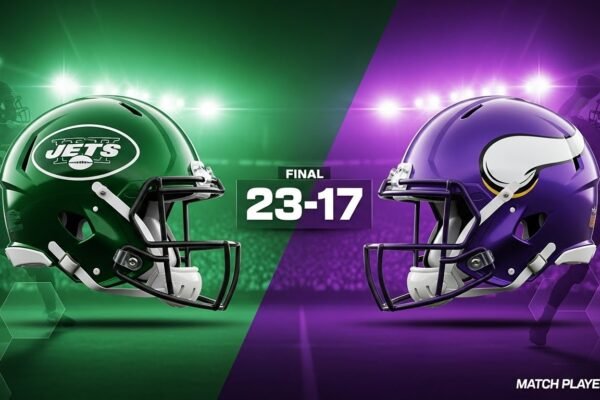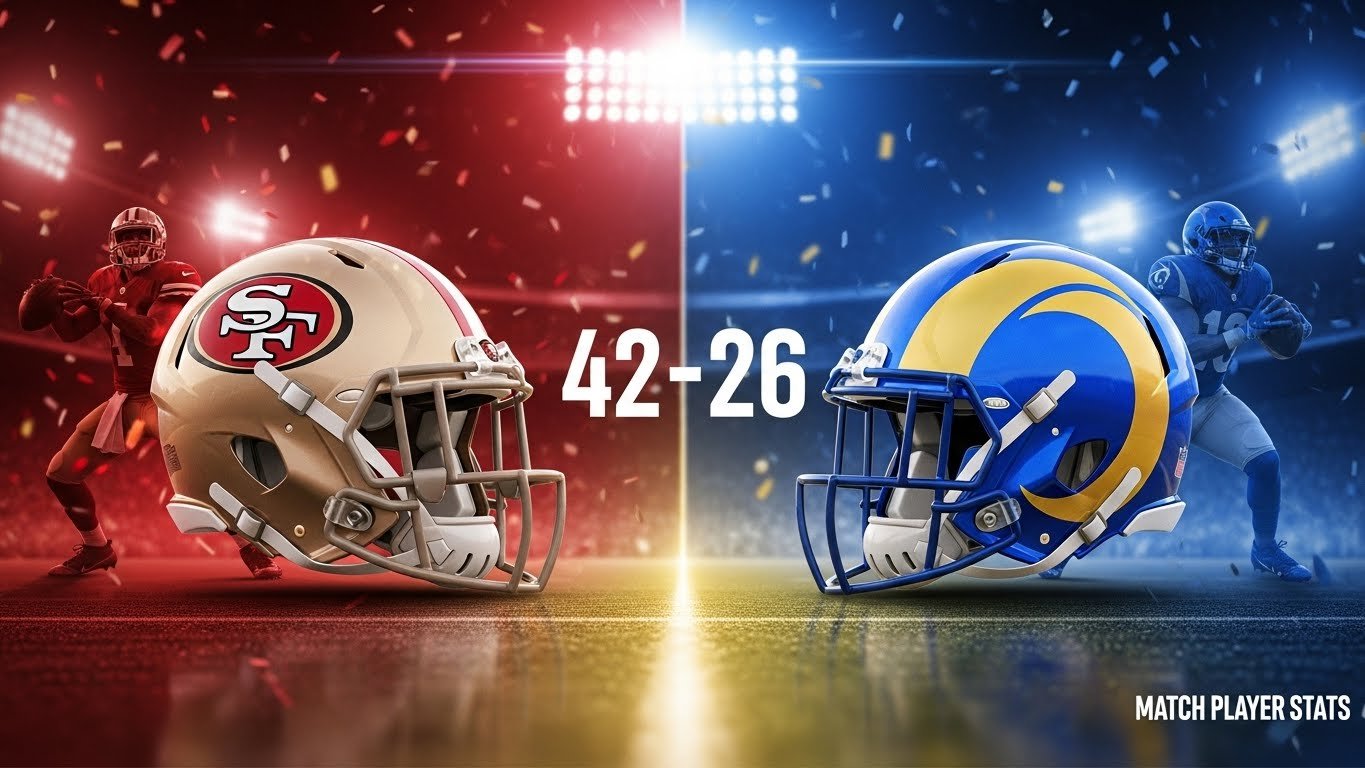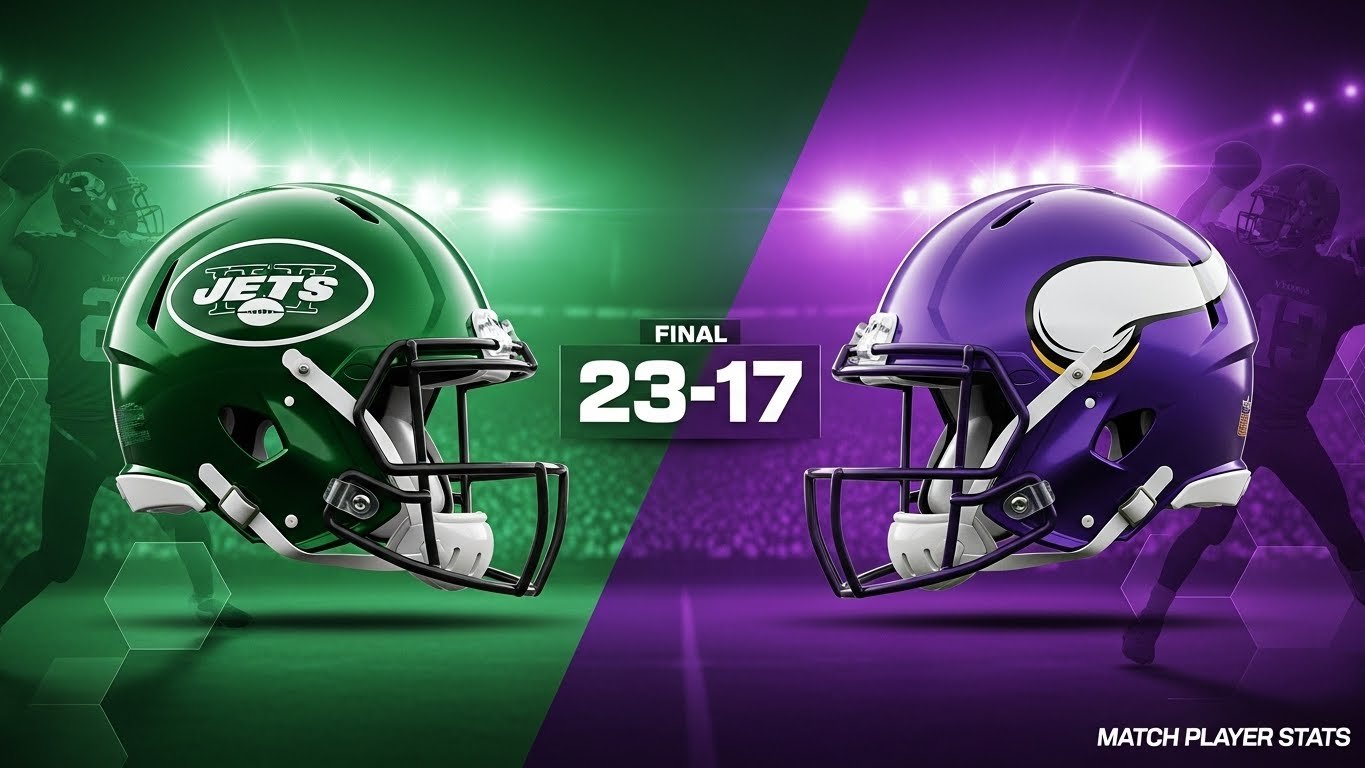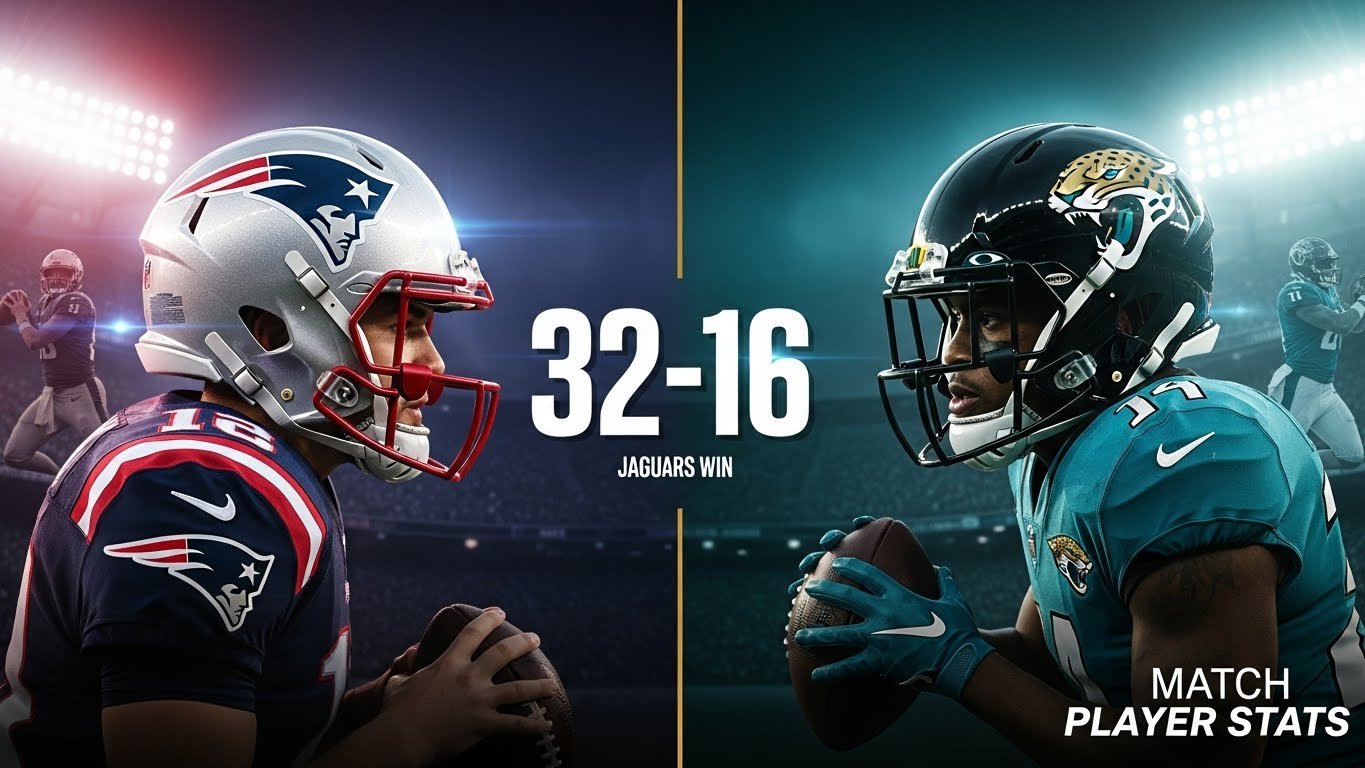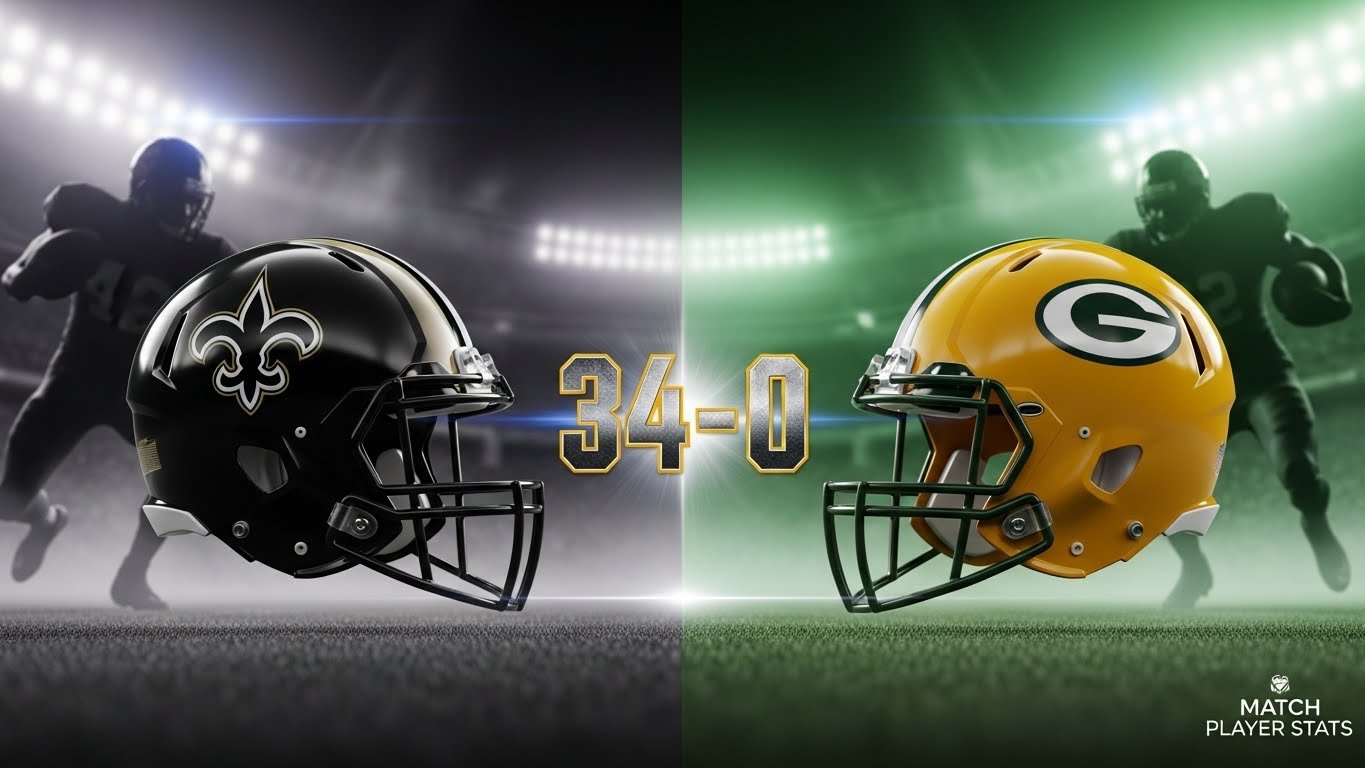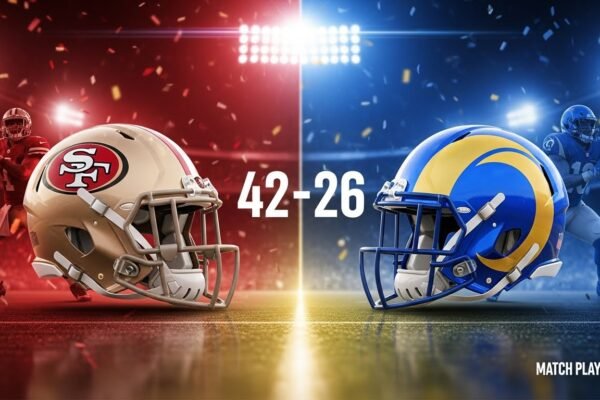
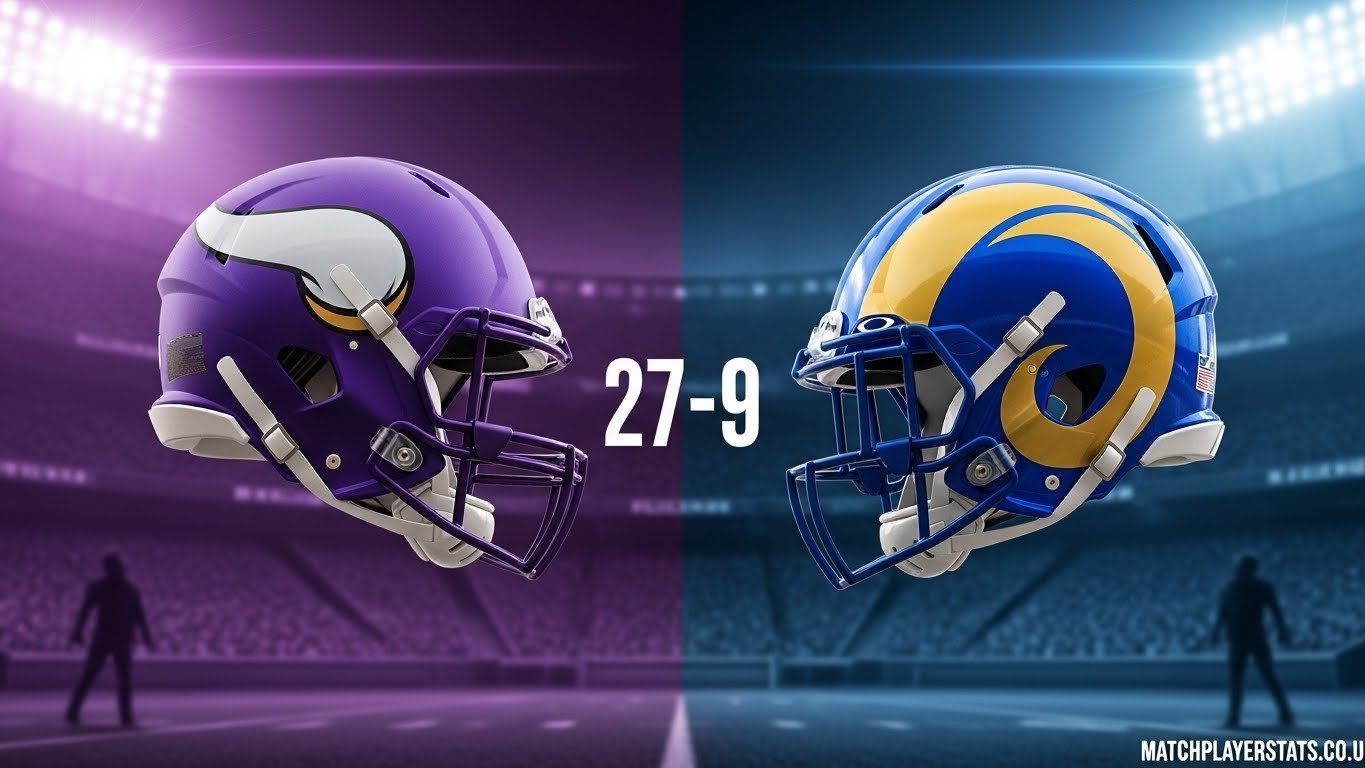
Minnesota Vikings vs Los Angeles Rams Match Player Stats (Jan 13, 2025)
Los Angeles demolished Minnesota 27 to 9 in the NFC Wild Card round on January 13, 2025. Sam Darnold got sacked nine times, losing 82 yards behind a crumbling offensive line. Matthew Stafford completed 19 of 27 passes for 209 yards and two touchdowns. Jared Verse scooped a fumble and sprinted 57 yards to the end zone. The Rams defense recorded nine sacks, tying an NFL playoff record set in 1963.
Devastating wildfires forced the NFL to relocate this game from Los Angeles to State Farm Stadium in Glendale, Arizona. Around 45,000 Rams fans made the 400 mile trip east, filling the stadium alongside Vikings supporters. The game kicked off Monday night at 8:00 PM ET under a closed retractable roof.
Table of Contents
Quick Stats Summary
| Category | Vikings | Rams |
|---|---|---|
| Final Score | 9 | 27 |
| Total Yards | 269 | 292 |
| Turnovers | 2 | 0 |
| Time of Possession | 32:18 | 27:42 |
| Third Down | 6/17 (35.3%) | 2/10 (20.0%) |
| Sacks Allowed | 9 | 2 |
Score By Quarter
| Quarter | Vikings | Rams |
|---|---|---|
| Q1 | 0 | 10 |
| Q2 | 3 | 14 |
| Q3 | 6 | 3 |
| Q4 | 0 | 0 |
| Final | 9 | 27 |
Los Angeles led 24 to 3 at halftime. Minnesota never recovered.
The individual numbers explain exactly how this unfolded.
Passing Stats
Minnesota Passing
| Player | Comp | Att | Yards | TD | INT | Rating | Sacks | Lost Yards |
|---|---|---|---|---|---|---|---|---|
| Sam Darnold | 25 | 40 | 245 | 1 | 1 | 77.6 | 9 | 82 |
Darnold held the ball at least 3.2 seconds on all six first half sacks, according to NFL Next Gen Stats. Four sacks lasted 4.4 seconds or longer. The Rams blitzed cornerbacks, stunted defensive linemen, and dropped into coverage when Darnold expected man coverage. His receivers couldn’t separate while his protection collapsed repeatedly.
Los Angeles Passing
| Player | Comp | Att | Yards | TD | INT | Rating | Sacks | Lost Yards |
|---|---|---|---|---|---|---|---|---|
| Matthew Stafford | 19 | 27 | 209 | 2 | 0 | 117.7 | 2 | 7 |
Stafford completed his first 10 passes. The 36 year old veteran picked apart Minnesota’s coverage on the opening drive and maintained control throughout. He broke a three game streak of passing for fewer than 200 yards.
Darnold had no time. His receivers had no space. The ground game couldn’t compensate.
Rushing Stats
Minnesota Rushing
| Player | Carries | Yards | Avg | TD | Long |
|---|---|---|---|---|---|
| Aaron Jones | 13 | 48 | 3.7 | 0 | 13 |
| Cam Akers | 5 | 39 | 7.8 | 0 | 26 |
| Sam Darnold | 4 | 19 | 4.8 | 0 | 17 |
| Team | 22 | 106 | 4.8 | 0 | 26 |
Los Angeles Rushing
| Player | Carries | Yards | Avg | TD | Long |
|---|---|---|---|---|---|
| Kyren Williams | 16 | 76 | 4.8 | 0 | 17 |
| Ronnie Rivers | 3 | 8 | 2.7 | 0 | 5 |
| Puka Nacua | 1 | 7 | 7.0 | 0 | 7 |
| Matthew Stafford | 2 | -1 | -0.5 | 0 | 0 |
| Team | 22 | 90 | 4.1 | 0 | 17 |
Williams carried 16 times for 76 yards. The Rams controlled possession for 38 minutes and 30 seconds while Minnesota ran 22 times but averaged just 4.8 yards per carry. The Vikings couldn’t establish anything on the ground.
Receiving Stats
Minnesota Receiving
| Player | Rec | Tgt | Yards | Avg | TD | Long |
|---|---|---|---|---|---|---|
| T.J. Hockenson | 5 | 5 | 64 | 12.8 | 1 | 26 |
| Justin Jefferson | 5 | 8 | 58 | 11.6 | 0 | 22 |
| Jalen Nailor | 3 | 5 | 33 | 11.0 | 0 | 14 |
| Jordan Addison | 3 | 8 | 29 | 9.7 | 0 | 15 |
| Johnny Mundt | 2 | 3 | 28 | 14.0 | 0 | 22 |
| Aaron Jones | 3 | 6 | 12 | 4.0 | 0 | 8 |
| C.J. Ham | 1 | 1 | 8 | 8.0 | 0 | 8 |
| Trent Sherfield | 2 | 3 | 8 | 4.0 | 0 | 7 |
Jefferson caught just five of eight targets. Los Angeles eliminated deep routes with safety help over the top and forced checkdowns. The short completions accumulated yards but went nowhere.
Los Angeles Receiving
| Player | Rec | Tgt | Yards | Avg | TD | Long |
|---|---|---|---|---|---|---|
| Tyler Higbee | 5 | 5 | 58 | 11.6 | 0 | 23 |
| Puka Nacua | 5 | 9 | 44 | 8.8 | 0 | 27 |
| Cooper Kupp | 1 | 1 | 29 | 29.0 | 0 | 29 |
| Demarcus Robinson | 1 | 2 | 23 | 23.0 | 0 | 23 |
| Kyren Williams | 3 | 3 | 16 | 5.3 | 1 | 6 |
| Davis Allen | 1 | 2 | 13 | 13.0 | 1 | 13 |
| Hunter Long | 1 | 2 | 13 | 13.0 | 0 | 13 |
| Colby Parkinson | 2 | 2 | 13 | 6.5 | 0 | 7 |
Higbee caught five passes for 58 yards before leaving with a chest injury. His early production opened up everything else for Stafford.
Minnesota’s pass catchers had no answers. Jefferson couldn’t work deep routes because Darnold had no time to throw. The checkdowns accumulated yards but went nowhere. The real destruction showed up in the defensive numbers.
Defensive Stats
Minnesota Defense
| Player | Tackles | Solo | Sacks | TFL | QB Hits | INT |
|---|---|---|---|---|---|---|
| Blake Cashman | 11 | 5 | 1.0 | 0 | 1 | 0 |
| Ivan Pace Jr. | 10 | 7 | 0.0 | 2 | 0 | 0 |
| Harrison Smith | 9 | 3 | 0.0 | 0 | 1 | 0 |
| Andrew Van Ginkel | 3 | 1 | 1.0 | 1 | 1 | 0 |
| Josh Metellus | 3 | 2 | 0.0 | 0 | 0 | 0 |
| Byron Murphy Jr. | 3 | 2 | 0.0 | 1 | 0 | 0 |
| Jonathan Greenard | 3 | 2 | 0.0 | 0 | 1 | 0 |
| Camryn Bynum | 3 | 1 | 0.0 | 0 | 0 | 0 |
Minnesota managed just two sacks and five quarterback hits against Stafford. The pass rush failed to generate consistent pressure throughout the game.
Los Angeles Defense
| Player | Tackles | Solo | Sacks | TFL | QB Hits | INT |
|---|---|---|---|---|---|---|
| Quentin Lake | 9 | 6 | 0.0 | 1 | 0 | 0 |
| Christian Rozeboom | 7 | 4 | 0.0 | 0 | 0 | 0 |
| Kamren Kinchens | 6 | 4 | 0.0 | 0 | 0 | 0 |
| Kobie Turner | 4 | 2 | 2.0 | 2 | 2 | 0 |
| Neville Gallimore | 5 | 2 | 1.5 | 1 | 2 | 0 |
| Byron Young | 4 | 3 | 1.5 | 2 | 2 | 0 |
| Ahkello Witherspoon | 3 | 3 | 1.0 | 1 | 1 | 0 |
| Cobie Durant | 2 | 1 | 1.0 | 1 | 1 | 1 |
| Desjuan Johnson | 1 | 1 | 1.0 | 1 | 1 | 0 |
| Michael Hoecht | 4 | 1 | 0.5 | 0 | 2 | 0 |
| Braden Fiske | 1 | 0 | 0.5 | 0 | 1 | 0 |
Eight different players recorded at least half a sack, per ESPN’s box score. The young defensive line of Verse, Fiske, Young, and Turner combined for 25 quarterback pressures, according to Pro Football Focus.
Special Teams Stats
Kicking
| Team | Kicker | FG | Long | XP | Points |
|---|---|---|---|---|---|
| Vikings | Will Reichard | 1/1 | 34 | 0/0 | 3 |
| Rams | Joshua Karty | 2/2 | 44 | 3/3 | 9 |
Punting
| Team | Punter | Punts | Yards | Avg | In 20 |
|---|---|---|---|---|---|
| Vikings | Ryan Wright | 3 | 133 | 44.3 | 0 |
| Rams | Ethan Evans | 5 | 251 | 50.2 | 3 |
Evans pinned Minnesota inside the 20 three times. Field position became a major factor throughout the game.
Team Comparison
| Category | Vikings | Rams |
|---|---|---|
| First Downs | 20 | 16 |
| Passing Yards | 163 | 202 |
| Rushing Yards | 106 | 90 |
| Total Plays | 71 | 51 |
| Yards Per Play | 3.8 | 5.7 |
| Penalties | 2 for 20 | 10 for 95 |
| Red Zone | 0/1 | 2/4 |
Los Angeles averaged 5.7 yards per play compared to Minnesota’s 3.8. That efficiency gap decided everything.
Why The Pass Protection Collapsed
The nine sacks didn’t happen by accident. They came from a calculated defensive game plan that exploited every weakness in Minnesota’s pass protection scheme.
Los Angeles used man coverage on 12 of Darnold’s 40 pass attempts. He completed just four of 12 passes for 64 yards with one touchdown and one interception against man coverage, according to NFL sources. The Rams disguised their coverages pre-snap, showing zone before rotating to man just as the ball was snapped. Darnold held the ball as receivers tried to break free from tight coverage. They rarely did.
Defensive coordinator Chris Shula mixed his pass rush schemes constantly. Cornerback blitzes. Delayed linebacker rushes. Defensive line stunts with guards picking up the wrong rusher. Minnesota’s offensive line couldn’t adjust fast enough. Blake Brandel and Dalton Risner got beaten on inside moves. Cam Robinson and the left side struggled with speed rushers.
Four of the nine sacks came on third or fourth down. Clutch pressure killed any comeback hopes before they started.
First Half Destruction
Stafford completed all six passes on the opening drive, finishing with a five yard touchdown to Kyren Williams. Seven plays covered 70 yards in 4:38.
Rams 7, Vikings 0.
Minnesota got on the board with a 34 yard field goal at 14:17 of the second quarter. Then disaster struck.
On third and seven from the Rams 38, Ahkello Witherspoon blitzed from the left corner spot. No one picked him up. He crushed Darnold from behind. The ball popped loose at the 43 yard line.
Jared Verse grabbed it. Every Vikings defender started pursuing. None got close. He crossed midfield at full speed, hit the 30, then the 20, then somersaulted into the end zone. The stadium erupted. Clock showed 4:35 left in the half.
Rams 17, Vikings 3.
Verse reached 19.88 mph on the return, the fastest speed by a 260 plus pound ball carrier in the past seven seasons, according to Next Gen Stats. The rookie linebacker became the first rookie with a defensive touchdown in a playoff game since J.J. Watt in 2011.
Minnesota faced fourth and two from the Rams 50 with the score at 17 to 3. Kevin O’Connell went for it. Kobie Turner blew past Blake Brandel on a defensive line stunt and dropped Darnold for an 11 yard loss.
Five plays later, Stafford hit Davis Allen for a 13 yard touchdown with 15 seconds remaining.
Rams 24, Vikings 3.
The Vikings ran 31 offensive plays in the first half and managed just three points. Their 14 game winning streak belonged to a different season.
Historic Sack Performance
Los Angeles recorded nine sacks, matching the NFL playoff record set by the Chicago Bears against the New York Giants in the 1963 NFL Championship Game, per Pro Football Reference.
Complete Breakdown:
First Quarter, 9:42 Byron Young dropped Darnold for 10 yards on Minnesota’s second offensive play.
Second Quarter, 12:22 Cobie Durant got him for 12 yards on second and three.
Second Quarter, 4:48 Witherspoon strip sacked him for five yards, leading to Verse’s touchdown return.
Second Quarter, 3:14 Byron Young and Neville Gallimore combined for seven yards.
Second Quarter, 1:31 Kobie Turner sacked him for 11 yards on fourth and two from midfield.
Third Quarter, 8:06 Andrew Van Ginkel dropped him for seven yards on third and five.
Third Quarter, 3:33 Blake Cashman got him for no gain.
Fourth Quarter, 12:54 Michael Hoecht and Braden Fiske teamed up for 13 yards on third and eight.
Fourth Quarter, 1:53 Desjuan Johnson closed things with a nine yard sack.
Turner led with 2.0 sacks. Gallimore and Young each recorded 1.5. Four came on third or fourth down, according to Vikings.com.
Individual Performances
Sam Darnold completed 62.5 percent of his passes but got destroyed by constant pressure. His 77.6 passer rating marked his second straight poor performance after dominating most of the regular season. He finished with a 106.4 passer rating through 17 games but posted just 66.4 over his final two contests.
Both losses.
Earlier in the season, Darnold threw two touchdowns and completed 79 percent of his passes in Minnesota’s season opener against the Giants. That version disappeared when January arrived.
Matthew Stafford completed 70.4 percent of his passes for a 117.7 rating. Both touchdown throws came in crucial moments. The veteran quarterback showed the same poise he displayed in December when he threw for 320 yards in a shootout with Buffalo.
Jared Verse dominated as the Defensive Rookie of the Year frontrunner. His fumble return touchdown shifted all momentum. His relentless pressure forced Minnesota’s offensive line into panic mode all night.
T.J. Hockenson caught all five targets for 64 yards and scored Minnesota’s only touchdown on a 26 yard reception in the third quarter. A failed two point conversion kept the score at 27 to 9.
Kyren Williams caught the opening touchdown and carried 16 times for 76 yards. Sean McVay leaned on him to control possession and limit Minnesota’s offensive opportunities.
What This Loss Meant
Minnesota finished 14 and 4 after dominating the regular season. They lost to Detroit twice in the final two weeks and never recovered their momentum. Kevin O’Connell’s squad won 14 games but couldn’t advance past the wild card round for the second time in three playoff appearances under his coaching.
The Vikings offense ranked sixth in passing yards and ninth in scoring during the regular season. They managed 163 passing yards and nine points in the playoff opener. The offensive line gave up nine sacks. Receivers failed to separate against tight coverage. Jones managed just 48 yards on 13 carries.
Brian Flores’ aggressive defense generated just two sacks and five quarterback hits against Stafford. That wouldn’t beat anybody in January.
Los Angeles improved to 11 and 7 and earned a divisional round trip to Philadelphia. The Rams won 10 of their final 13 games after starting 1 and 4. Their young defensive line dominated down the stretch, finishing with a plus eight turnover margin since their bye week. They added two more turnovers in this wild card victory.
Darnold played on a one year deal. He threw 35 touchdown passes in his first 17 games but just one in the final two contests. Teams questioned whether he could handle playoff intensity after getting overwhelmed twice in consecutive weeks.
The Vikings faced a decision about bringing him back or turning to rookie J.J. McCarthy, who missed his entire first season with a knee injury. Darnold’s market value dropped significantly.
Aaron Jones played on a one year contract and rushed for 1,138 yards during the regular season. At 30 years old, his future remained uncertain.
The game relocated from SoFi Stadium because devastating wildfires tore through Los Angeles County. Players and coaches talked about representing their city during a crisis. Sean McVay addressed it postgame: “You talk about sports offering a platform for people to come together and offer a little temporary relief. I thought the way our team competed tonight was what that looked like.”
The NFL donated all ticket proceeds to wildfire relief efforts.
Minnesota won 14 regular season games and earned the fifth seed, then lost in the first round at a neutral site. Their offensive line collapsed. Darnold held the ball too long. The defense managed only two sacks. Their 14 game winning streak meant nothing once the calendar turned to January. This playoff loss defined their 2024 season more than any regular season victory ever could.


